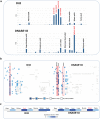Oit3, a promising hallmark gene for targeting liver sinusoidal endothelial cells
- PMID: 37696816
- PMCID: PMC10495338
- DOI: 10.1038/s41392-023-01621-2
Oit3, a promising hallmark gene for targeting liver sinusoidal endothelial cells
Abstract
Liver sinusoidal endothelial cells (LSECs) play a pivotal role in maintaining liver homeostasis and influencing the pathological processes of various liver diseases. However, neither LSEC-specific hallmark genes nor a LSEC promoter-driven Cre mouse line has been introduced before, which largely restricts the study of liver diseases with vascular disorders. To explore LSEC-specific hallmark genes, we compared the top 50 marker genes between liver endothelial cells (ECs) and liver capillary ECs and identified 18 overlapping genes. After excluding globally expressed genes and those with low expression percentages, we narrowed our focus to two final candidates: Oit3 and Dnase1l3. Through single-cell RNA sequencing (scRNA-seq) and analysis of the NCBI database, we confirmed the extrahepatic expression of Dnase1l3. The paired-cell sequencing data further demonstrated that Oit3 was predominantly expressed in the midlobular liver ECs. Subsequently, we constructed inducible Oit3-CreERT2 transgenic mice, which were further crossed with ROSA26-tdTomato mice. Microscopy validated that the established Oit3-CreERT2-tdTomato mice exhibited significant fluorescence in the liver rather than in other organs. The staining analysis confirmed the colocalization of tdTomato and EC markers. Ex-vivo experiments further confirmed that isolated tdTomato+ cells exhibited well-differentiated fenestrae and highly expressed EC markers, confirming their identity as LSECs. Overall, Oit3 is a promising hallmark gene for tracing LSECs. The establishment of Oit3-CreERT2-tdTomato mice provides a valuable model for studying the complexities of LSECs in liver diseases.
© 2023. West China Hospital, Sichuan University.
Conflict of interest statement
The authors declare no competing interests.
Figures






References
-
- Gracia-Sancho J, Caparros E, Fernandez-Iglesias A, Frances R. Role of liver sinusoidal endothelial cells in liver diseases. Nat. Rev. Gastroenterol. Hepatol. 2021;18:411–431. - PubMed
-
- Gage BK, et al. Generation of functional liver sinusoidal endothelial cells from human pluripotent stem-cell-derived venous angioblasts. Cell Stem Cell. 2020;27:254–269.e259. - PubMed
MeSH terms
Substances
LinkOut - more resources
Full Text Sources
Other Literature Sources

